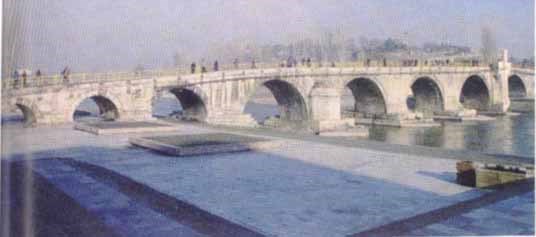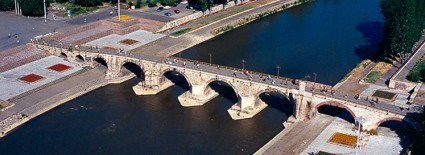The Stone Bridge Skopje
In the absence of precise historic sources and records, there are two different opinion on the dating of the Bridge.
 One of them says that it was built during the Romans, in the VI century A.D. immediately after the disastrous 518 earthquake, when also the Classical town of Skupi was devastated. The other, and the more probable one, says that it was built during the Ottoman rule, i.e., in the second half of the XV century, between 1451 and 1469, under the patronage of Sultan Mehmed III the Conqueror.
One of them says that it was built during the Romans, in the VI century A.D. immediately after the disastrous 518 earthquake, when also the Classical town of Skupi was devastated. The other, and the more probable one, says that it was built during the Ottoman rule, i.e., in the second half of the XV century, between 1451 and 1469, under the patronage of Sultan Mehmed III the Conqueror.
The earliest mention of the Bridge in the historic records is contained in the vakafnamata (records) of Isa - Beg's Aladza (Motley) Mosque, in 874 according to Hijra, i.e., 1469 A.D. Its master-builders are unknown.
The original shape of the Bridge consisted of 13 vaults with a total length of 329 local feet or 213.85 metres (one foot = 0.65m). The total width of the Bridge was 6.33 m. That was the Bridge as seen and described by the Venetian Giacoppo Soronze who, on his journey to Constantinople (1575), stayed in Skopje.
The Bridge was built of masterly and precisely aligned travertine blocks, jointed by iron rods, and strengthened by cast lead, chiseled stone and mortar applied inside the pillars. Some of them, for example the central pillar, which in the upper section ends with a decorative niche (a sentry box) similar to mihrab - in the interior have large rooms with double function, primarily to minimize the overloading of the pillar, and then to serve as a loophole. During its designing, also the decoration of the facades was taken into account, by using the renown ornamental elements (stalactites) of the Islamic secular and sacral architecture.
Over time the Bridge suffered a number of impairments, which required particular reconstruction activities. There are records for some of them. Thus, it is known for certain that the Bridge was damaged in the disastrous 1555 earthquake. Then four pillars were either ruined or severely damaged. Turkish travels-writer Evlija Celebija, who stayed in the city in 1660/61, is quoting the inscription placed on the bridge on the occasion of its reconstruction: "When people saw this unrivaled bridge restored, they praised it by saying: "It is much more beautiful than it used to be."" It was reconstructed in 987 according to Heira, i.e., 1579 A.D. The reconstructed Bridge survived the frequent overflowing of the river. However, in 1817/18, during Sultan Mahmud II (1808-1839), a new reconstruction was carried out. The records say it was paid 28,816 "grosa" and 2 "aspri" (former currency). There were also subsequent reconstruction activities. Thus, before 1885 the arks and vault on the north-east side were repaired, using the bricks for the vaults and stone blocks for the lower sections of the pillars. Throughout its life, until 1909, the Bridge had a fence made up of stone slabs.
 In 1895, as a number of times before, the Bridge was again endangered by the flooding waters of the rivers Treska, Lepenec, and Vardar. Therefore, in the following years (1896 and 1897) protective walls were built on the quay, as one of the measures for regulating the river flow in that area.
In 1895, as a number of times before, the Bridge was again endangered by the flooding waters of the rivers Treska, Lepenec, and Vardar. Therefore, in the following years (1896 and 1897) protective walls were built on the quay, as one of the measures for regulating the river flow in that area.
One, today lost stone slob, which was on the Bridge until 1963 and whose inscribed wording was copied and thus preserved, reveal that Sultan Mehmed II Resat in 1909 instructed the expansion of the Bridge by metal consoles that supported the sidewalk along its two sides.
Thus the roadway was widened from 6.33 to 9.80 m.
In 1944 the invading nazi army mined the Bridge. However, on the liberation of the city the activation of the dynamite was prevented. Thus the Bridge was saved from a disastrous breakdown.
In 1992 a new reconstruction activity was undertaken, aimed at restoring its original shape. Thus, the sidewalks above the iron consoles were removed, and the original width of the bridge was restored. It is expected that also the original fence made up of stone slobs will be restored.
Source: Kameniot Most na Vardar, Skopje

The cache is just an "envelope" in folio. Please, be extremely cautious when looking for it! This place is very crowded, especially during weekends and evenings!